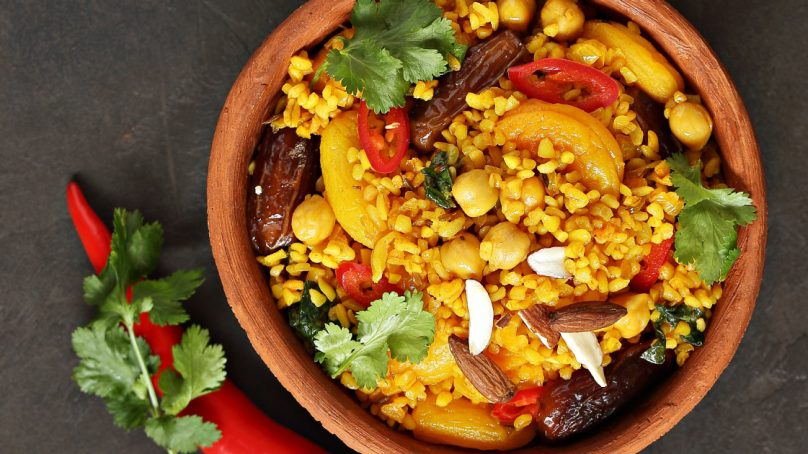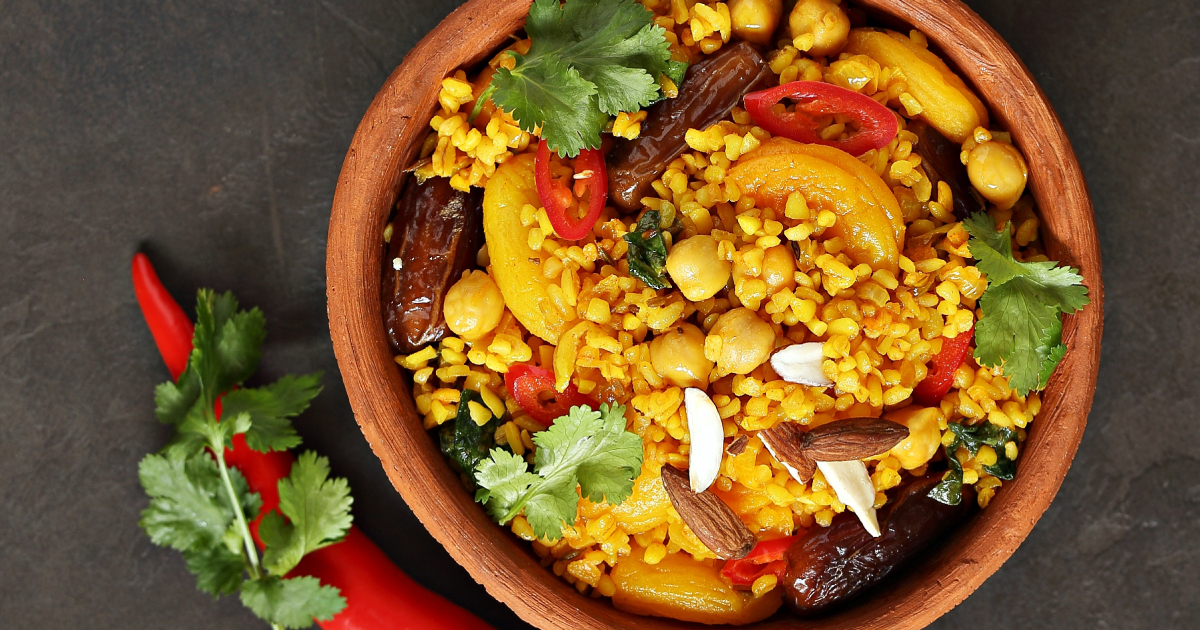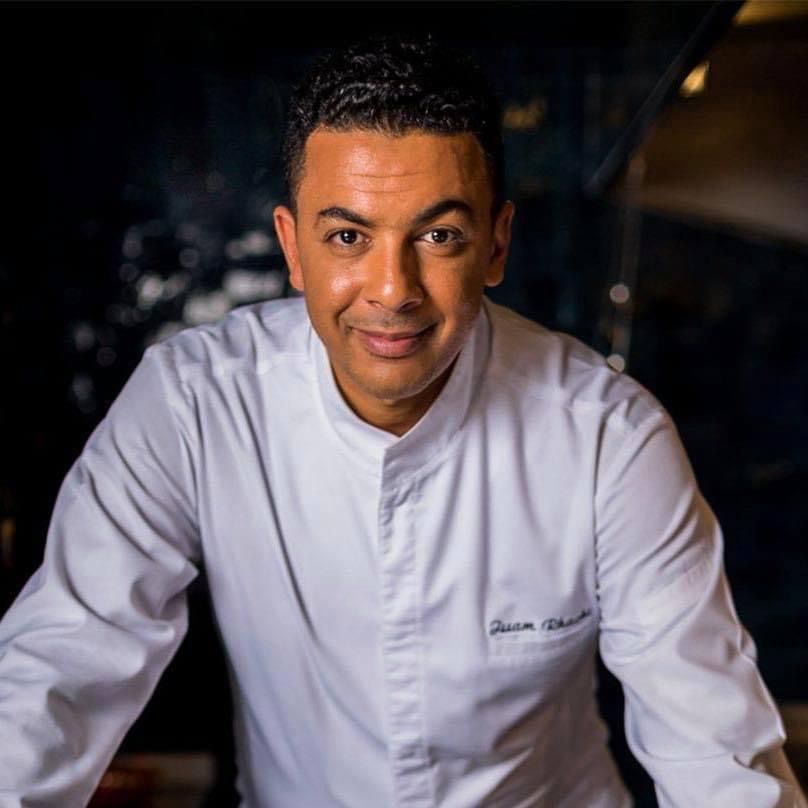

Moroccan cuisine is an astonishing blend of flavors, colors and cultures, inspired by the culinary traditions of the Middle East, North Africa and Spain. The uniqueness of Moroccan cuisine lies in the diversity of its cultural heritage; its history dates back thousands of years, molded by the blending of numerous civilizations, including Berber, Carthaginian, Roman, Arab, Islamic and Andalusian societal groups.
While Moroccan cuisine has much in common with those of other North African countries, it retains several distinguishing features, one of which is that many variations of the same recipe can be found in different regions. In this way, each Moroccan territory is home to its own unique dishes. Tangier tajine differs from Masfioui tajine and Berber tajine, for example, since each region uses its own blend of spices and local products.
These play a key role in Moroccan cuisine, with Taliouine saffron, organic Irzane saffron, Argan oil, olive oil, olives, cumin, Serghina, preserved lemons and terfesse among the ingredients adding authenticity to dishes that are then brought to life by local cooking methods.
Returning from a culinary trip to Tunisia, I couldn’t help noticing how the highly masterful balance of spices gives Moroccan recipes an original taste and know-how compared to other North African recipes. Today, Moroccan chefs are working to create a fusion of this diverse cuisine, adding new elements, while retaining the originality of Moroccan gastronomy.
Regional differences and discoveries
While visiting rural villages, I was fascinated to discover regional varieties of the same dish, distinguished by the use of various cooking techniques, all of which were equally magnificent. For example, the flagship dish of the red city (Marrakech) is tanjia, which is prepared with beef shank, preserved lemons, garlic, saffron, cumin and olive oil, cooked under ashes (fernatchi) for two hours and prepared by men.
It’s worth noting here that Moroccans pioneered the low-temperature cooking technique. Northern Moroccan cuisine, meanwhile, is influenced by Spanish cooking methods, with many of the popular dishes in the Tangiers based on seafood, including tagra (fish stew), its star dish. Further east, there are signs of the influence of Algerian cuisine, which itself is evidence of the Ottoman presence, with berkoukes and brania high on the list of well-known dishes from this region. The recipe for brania, in fact, provided the inspiration for a dish I served in a Moroccan restaurant I recently designed. The cuisine of the Rabat-Casablanca region is typically Moorish and is the source of Moroccan gastronomy, including pastilla and kadra r’batiya, (almond paste cakes). Fassi cuisine, which has gained a Jewish imprint, is one of the specialties of this region. Couscous with fish, tajine with conger eel and street food, such as sardines served with tomato and onion salad, are among the best-known specialties of the Essaouira-Safi region. The Sousse region, meanwhile, is renowned for its tajines and Argan oil dishes. However, the cuisine of the south is perfumed by the products of the Sahara, with the star dish of this region being camel meat, cooked in the sand with charcoal for an entire day.
From family homes to the world stage
Rituals and rites around Moroccan cuisine have their roots in Islamic civilization. We always pronounce the name of Allah before we begin eating and we eat with our right hand. The meat we eat must have a Halal label.
It is also a cuisine with hospitality at its heart, marked by sharing, with several people eating a dish, such as the staple couscous, which is prepared for lunch every Friday, from the same plate.
True Moroccan cuisine is found in the homes of our grandmothers and, for many decades, their recipes were confined to the home kitchen, handed down from mother to daughter. Moroccan gastronomy has remained grandmotherly, authentic and generous, but today, it has also come out of its shell and takes pride of place in large, sophisticated restaurants locally and internationally.
Moroccan gastronomy was ranked second best globally in 2014 by the WorldSIM travel blog. More recently, in February 2023, the country took first prize for the second consecutive year at the Culinary World Cup, held in Tunisia. I’m one of a number of Moroccan chefs who has taken up the challenge of revisiting our grandmothers’ recipes.
I truly believe that while our cuisine is constantly evolving, it must be revisited without the loss of its character and history. To ensure this is the case, I’ve taken the opportunity to hone my talents through culinary trips to several local douars (villages), where I’ve discovered new cooking techniques and traditional and ancestral recipes.
Balancing tradition and current trends
In recent years, I’ve been able to design a restaurant that is purely Moroccan, in terms of décor, ambience and recipes, with the aim of bringing forgotten flavors back to life and creating a pathway from the countryside to the city. Significantly, I’ve also lightened the fat-rich local recipes to lower calorie intake, since I see my role as a professional chef and ambassador for Moroccan cuisine to find a balance between preserving the traditional touch in inherited recipes with making the national gastronomy healthier and more refined for tourists. Participating in several culinary events, such as Bocuse d’Or and Gault & Millau, I’m constantly on the lookout for new cooking techniques that can modify the taste, flavor, appearance, color, texture, volume, weight or nutritional qualities of our local products. Current culinary trends in Moroccan cuisine include the marriage of flavors, aromas and spices to create a lighter chermoula, and the introduction of gluten-free dishes for celiacs, such as baddaz – a Moroccan couscous with cornmeal.
Sealing a culinary heritage
This diversity of local products in Morocco is a key element in the success of its gastronomy, both nationally and internationally, with Moroccans among those still yet to discover just how extensive it is. I am confident that in just a few years, Moroccan cuisine will become a true part of our culinary heritage, making this gastronomy even more popular worldwide. The future of Moroccan cuisine lies in maintaining the traditional recipes and heritage, while developing them by making the dishes healthier and promoting vegetarian recipes, such as vegetable tajines, for example. Cooking shows, such as barbecue demonstrations in front of customers for boulfafe, are another way of spotlighting Moroccan cuisine. There is also plenty of potential for developing Moroccan street food which can be made at home and accommodated in healthy lifestyles through collaborations with associations and cooperatives. Rather than working on the fusion of Moroccan cuisine with other gastronomies, I’m concentrating on the melding of recipes from Morocco’s different regions – a combination of Tangier and Berber cuisines, for example – while also reviving ancestral Moroccan pastries like the famous dessert palivi de coco, which is trending in my restaurant. Enhancing the value of Moroccan gastronomy and continuing to seek out traditional, ancestral recipes from small villages in order to bring them to the fore, reviving the recipes of our grandmothers and publicizing our local products, are on my priority list.

Issam Rhachi,
executive chef at the Park Hyatt
hyatt.com


















